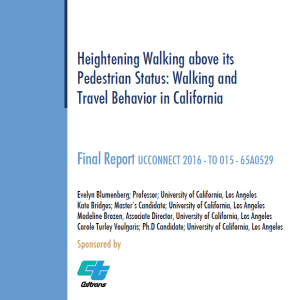
Authors: Evelyn Blumenberg, Kate Bridges, Madeline Brozen, Carole Turley Voulgaris
Date: June 30, 2016
Project: [wpv-post-link id=”$project”]
People walk a lot—to walk pets, to exercise and recreate, and to access public transit and local shops. Walk trips begin and end almost every journey, even trips made by automobile. Data from the current California Household Travel Survey (CHTS) show that walking occurs more than trips by both transit and bicycle, making it the second most common travel mode in California. Yet outside of select case studies in specific metropolitan areas, we know very little about walking behavior in California. An improved understanding of the determinants of walking will aid efforts to reduce driving and achieve greenhouse gas emission reduction targets.
In this study we draw on data from the last two California Household Travel Surveys to examine walking behavior in four major California regions—the San Francisco Bay Area, Los Angeles, Sacramento, and San Diego. The study includes four components; analyses of (a) the change in walking over time (b) the relationship between walking and the built environment (c) the determinants of change in walking over time and (d) the relationship between changes in neighborhood characteristics and changes in walking. In each of the analyses, we pay particular attention to differences across these four metropolitan regions. We pair our statistical analysis with a set of interviews intended to understand whether and how walking trips are included in regional travel demand models.
We find that, although walking remains a relatively small share (9%) of trips within the study area, walking rates have increased dramatically over time. The share of trips by walking grew almost twofold since 2001; from 5 percent to 9 percent. Moreover, while the share of walking trips is relatively small, walking mode shares are nine times higher than the percentage of trips taken by public transit or bicycle.
We further find that the decision to walk can be explained by a number of different factors including characteristics of the person, household, trip, and built environment as well as the region in which the trip occurs. We find that built environment characteristics are positively related to both (a) walking mode share and (b) changes in walking mode share over time. However, compared to other factors, built environment characteristics have a relatively small effect on walking, a finding that is consistent with other walking studies. However, our data also show that the characteristics of neighborhoods are slowly changing over time in ways that are conducive to walking, for example increasing housing and employment densities. Further, there is a strong relationship between walking and trip distance, which also is influenced by the built environment, particularly the quantity and quality of very local destinations.
With respect to the interviews, we find that most Metropolitan Planning Organizations (MPOs) have shifted to activity-based models, which are better suited to understanding walking compared to the traditional 4-step model. However, these models can be enhanced to improve their attention to and treatment of walking. There remains a mismatch between the goals of travel demand models (largely focused on the supply and demand for travel as represented by the highway and transit network) and walking. Additionally, travel demand modelers lack high quality, longitudinal data on the pedestrian volumes, flows and the pedestrian environment.
Combined, our analysis provides the basis for a set of recommendations to encourage walking and to better incorporate walking in future data collection efforts and regional travel demand models. These include:
1. A focus on increasing intersection densities and providing better pedestrian route directness.
2. Targeting changes in the built environment to population groups that already exhibit relatively high rates of walking. These changes might include addressing safety and crime issues as well as other issues affecting the pedestrian environment in low-income and immigrant neighborhoods where a disproportionate number of households do not own automobiles. Future developments may also involve improving the proximity of family and child-oriented amenities, such as high-quality schools and childcare facilities, which may increase opportunities for walking by members of households with young children, who are already more inclined to walk than their peers.
3. Adopting planning efforts to provide very local access (within a ½ mile) to important destinations (e.g. parks, gyms, and other fitness venues, restaurants, cultural institutions, and schools).
4. Collecting additional data on (a) walking behavior, (b) pedestrian volumes and location, and (c) the pedestrian environment over time.
Download Attachment